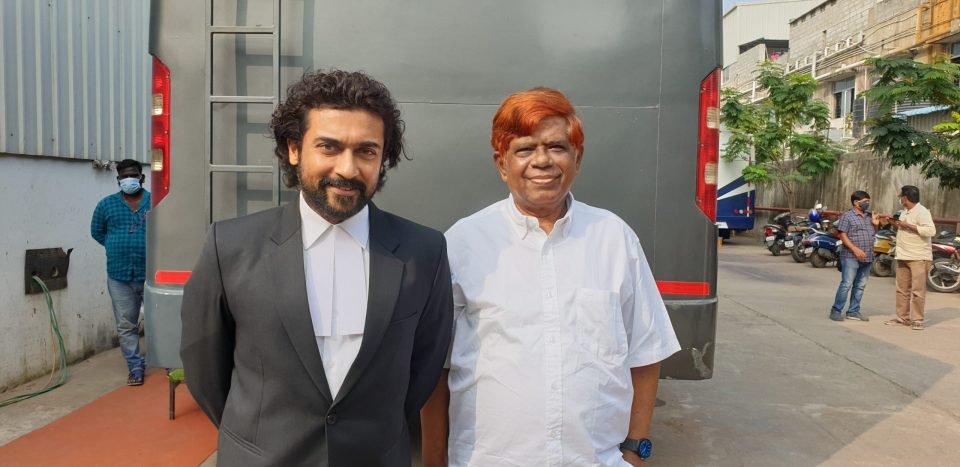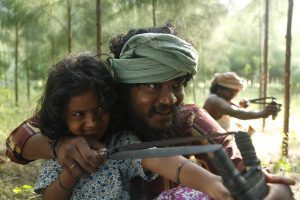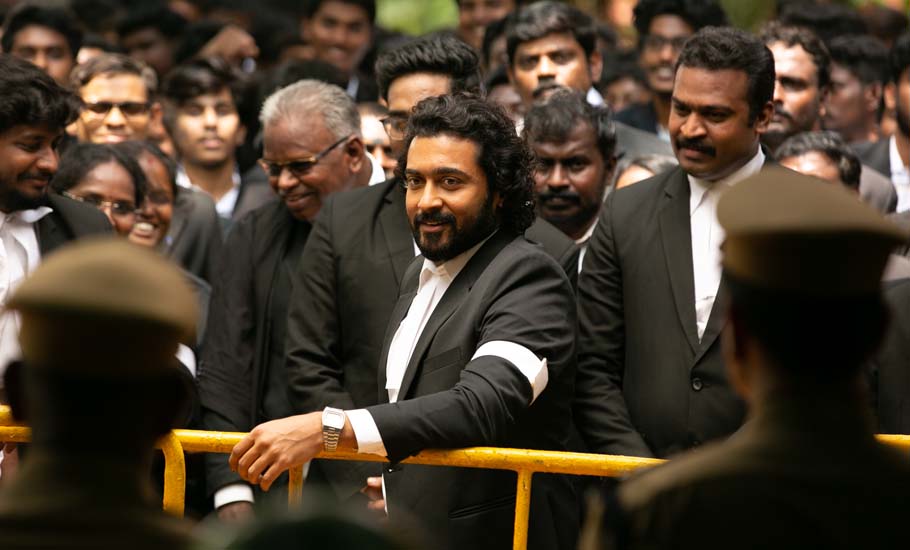
Surya was told no fight, no love: Justice Chandru on making of 'Jai Bhim'
‘Jai Bhim’ is a realistic, hard-hitting portrayal of police violence that irrevocably changes the life of a happy tribal couple in Vriddhachalam in Tamil Nadu. Rajakannu (played by Manikandan), an innocent Irula tribal eking out a living as a snake catcher, is falsely implicated in a robbery case and hauled off to the police station along with two of his relatives.

‘Jai Bhim’ is a realistic, hard-hitting portrayal of police violence that irrevocably changes the life of a happy tribal couple in Vriddhachalam in Tamil Nadu. Rajakannu (played by Manikandan), an innocent Irula tribal eking out a living as a snake catcher, is falsely implicated in a robbery case and hauled off to the police station along with two of his relatives.
Inside a dank and dirty cell, they are mercilessly and brutally beaten up and there is no let up here for them or for the viewer. His pregnant wife, Sengini (Lujomol Jose), too is kicked and beaten before she is let out. But matters take a turn for the worse as the police suddenly claim Rajakannu and his two relatives have escaped from custody. A frantic Sengini finally turns to Chandru (Surya, who has also produced the film), a practising lawyer in Madras High Court (HC) to locate her husband who is untraceable. And thus, setting off a courtroom drama which takes many twists and turns before the truth comes tumbling out.
Also read: ‘Jai Bhim’ and the cinema of emotional blackmail
The film, which is streaming on Amazon Prime Video, has picked up a lot of traction probably because of the presence of superstar Surya and since it is based on a true story which ends in a pyrrhic victory for the victims. The story has been built around a real case fought by former judge of Madras HC K. Chandru, back in 1993 [Justice Chandru was a lawyer back then]. Though Vetrimaran’s ‘Visaranai’ (India’s Oscar entry), ‘Kavalthurai Ungal Nanban’ etc., have tackled custodial torture, this film chillingly captures the elaborate lengths police go to hush up such institutional crimes.
In an interview with The Federal, Justice Chandru, who has been part of the film from the time of “story discussions to post-production,” says that ‘Jai Bhim’ is not a mere retelling of Sengini’s tragic tale. It is more about throwing light on the larger picture of the victimisation of vulnerable communities like the Irula tribe.
“In the film, the lawyer tells Sengini to continue fighting the case (even after she knows her husband is dead) because it can prevent another custodial death. At this point, Surya is taking the film to another level. Instead, of making a crime thriller based on one case, the film shows how the Irula community is slowly learning to fight back against police atrocities,” points out Justice Chandru, adding that young people troubled by the film are flooding him with emails.
“I am getting hundreds of emails from young people below 30 years telling me that they were unaware of such crimes and want to help in some way,” he says.
Twenty-five years later after the Sengini case, even today, Irula tribals are facing similar attacks all over south Arcot, he says. “But the difference is now the Irula tribals are fighting back. If there is an attack on an Irula village, immediately a SC/ST complaint is filed. There are a lot of cases filed against the police for torture and illegal custody,” says the former Judge . [The film shows clearly how the police foist false cases on tribals and vulnerable caste groups].

According to Justice Chandru, the “counter-attack” has begun. The film shows an organisation called the Pazhankudi Irular Trust in one shot, which is highly active in this area. In fact, actor Surya has donated ₹1 crore to the organisation through Tamil Nadu Chief Minister MK Stalin, who was also extremely moved by the film.
“The CM who came for the special preview and saw the film said he could not sleep after watching the film. These people clearly require our support, he said. So, to me, the film has clearly served a purpose—the head of state will think about this issue in the next planning process,” he points out, adding that all this (social impact) is moving faster than they had expected.
Also read: As theatres remain shut, Suriya inks deal with Amazon to release four films
That was the original intention behind making the film, says Justice Chandru, who has fought many such human rights abuse cases in his career. “That is why we gave the story a broader canvas and brought in how Irulas live, how they catch rats, snakes, and how they love the environment. The story was taken from the original case but we brought in the Irulas, who are organised now to give their movement a boost,” says Justice Chandru, who, in the 1990s, forgot about the case after getting the police officers sentenced to a 10-year RI. The tribal woman Parvathi was given a house site by the district collector and received compensation from the police as well.
“After that, I moved on and my connection with the case was severed. It was an individual case for me but ‘Jai Bhim’ director T.J. Gnanavel turned it into a social statement,” he adds.

Justice Chandru has been closely associated with the Tamil film industry for years, with many film stars like Parthiban and Ramba being his clients. On ‘Jai Bhim’s popularity, he says that one reason could be that audiences like court drama films which seem similar to a “John Grisham book.”
Though the film had a 30-minute court scene, it succeeded in keeping the court dialogues to the point so that a common man could understand them. “The court dialogues were rewritten a couple of times to make it more realistic,” he reveals. Talking about how Surya underplays the role and does not resort to any histrionics ‘Singam style’, Justice Chandru laughs and says, “Surya is a director’s man. Right in the beginning, he was told ‘no fight, no love.’ So, a major area for theatrics was cut out. Also, it is not a trial court proceeding where everyone shouts and indulges in hard-hitting repartee. If you shout in the HC, they will just throw you out. So, there is no scope for drama.”
Surya was “simply stunned” when he heard about the case, Justice Chandru recalls. “He is all praise for me in every interview and calls this role a great opportunity. After the preview, he asked me my opinion, I told him that i would have hugged him if he was beside me,” he said.
“Not to boast,” says the down-to-earth former HC Judge, “but a lot of TV channels are pursuing me after ‘Jai Bhim’ release. I am basking in the reflected glory.” However, Chandru is no stranger to the media having been in the public eye for the Prevention of Terrorism Act (POTA) case he had fought on behalf of Vaiko in 2003. As a judge, he is famous for having disposed of a record 96,000 cases in his seven-year tenure. He was known as the poor man’s lawyer and many journalists would contact him for his views on various issues related to human rights abuse.
When asked how he had fought this particular Rajakannu case when the police seemingly had a watertight case, he wryly replies, “I was a lawyer from 1976, working for a firm for seven years till 1983. In 1983, I became member of bar council and leader of Madras High Court Advocates’ Association. I came from background of activism (student activist for a Left movement), so it was not difficult.”
“Yes, the police had a water-tight case”, he adds, but there was an eyewitness in the lockup. Moreover, they were able to secure the eyewitnesses from Kerala, who had been deviously dispatched to jail on a false case.
“Once we got the two nephews of Rajakannu it became a cast-iron case. Secondly, even the IG of police Perumalswamy quickly investigated and filed an inquiry report within four weeks, which has never happened before. The case was disposed of by the High Court in record time by their standards, considering there are cases pending for over 20 years,” he says.
Also read: Jai Bhim raises pertinent questions about the abandoned scheduled tribes of Tamil Nadu
Chandru also advised the film-maker on designing the replica of the third hall of the Madras HC , which they had to create since shooting in the HC is forbidden. The set cost them heavily, but Justice Chandru had his way and got the portraits of his two role models, Justice Krishna Iyer and Justice Satyadev’s portraits to be hung on the walls.
“Usually there are portraits of judges from pre-independence days on the walls in Madras HC but they don’t have a portrait of Krishna Iyer. But at least now on film it is there,” says Justice Chandru, chuckling with delight.
Also, the film shows Justice Chandru’s own metamorphosis on the issue of striking lawyers. Though he had led many agitations as a lawyer, at some point, he changed his mind and felt it was counterproductive for a lawyer to strike, he reveals. “Courts are meant for litigants, I started to feel we should not strike but show our protest in different ways. That’s what Surya says in the film – it is more important to defend his clients victimised by the system. Later, as a judge, I also wrote orders that lawyers have no business to go on strike. Their constituency is clients, their demand should be fought in a different manner,” he says.
Justice Chandru says that he is also fending off criticism as people on social media have accused him of exaggerating the case and have even asked him to produce the original judgement. “It is currently circulating on social media. There are no secrets here. This not art or fiction, it has been in the law books for the past three decades,” he points out.
“I don’t blame people, no one accepts what you are saying today. They want to see for themselves in this age of fake news. One guy, however, called the film atrocity porn,” says Justice Chandru shrugging off the hate attacks.
He says, “What’s more important is to generate discussions on how to prevent lock-up deaths. To sensitise the police force, probably construct the police station differently making investigation chambers more open. We can change many things, I know that even today police officers have private torture chambers or they take the victim to some other station and start hitting. They can escape in many ways, wrong remands also keep happening all the time even today…”
To prove his point, he explains how the Irula women who were invited for the ‘Jai Bhim’ preview were left unmoved while other women were crying in the theatre. “They had no reaction because this is what they have to go through on a daily basis,” says Justice Chandru.


